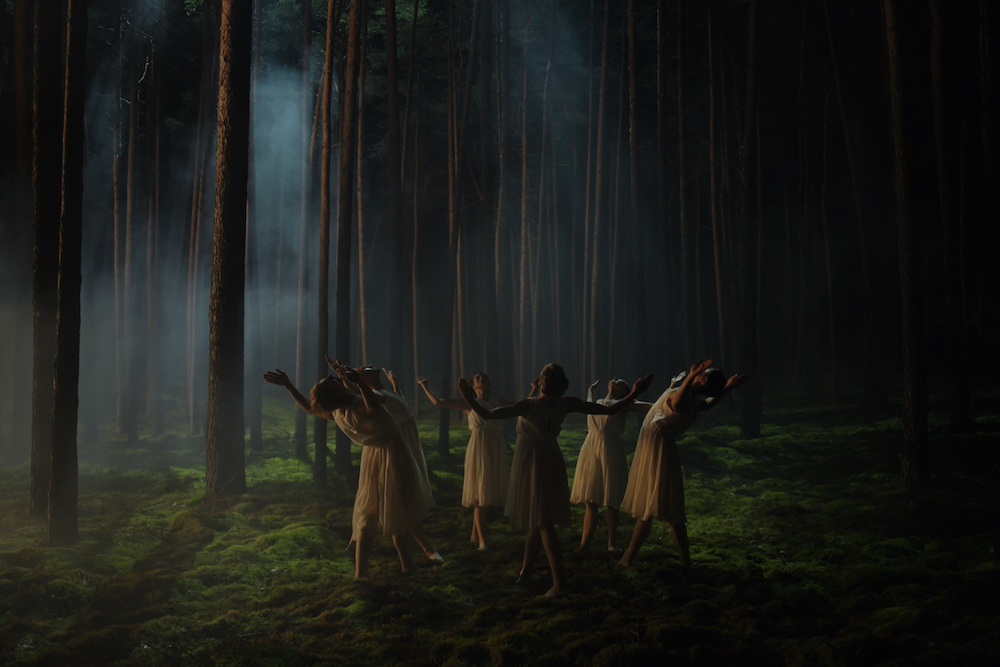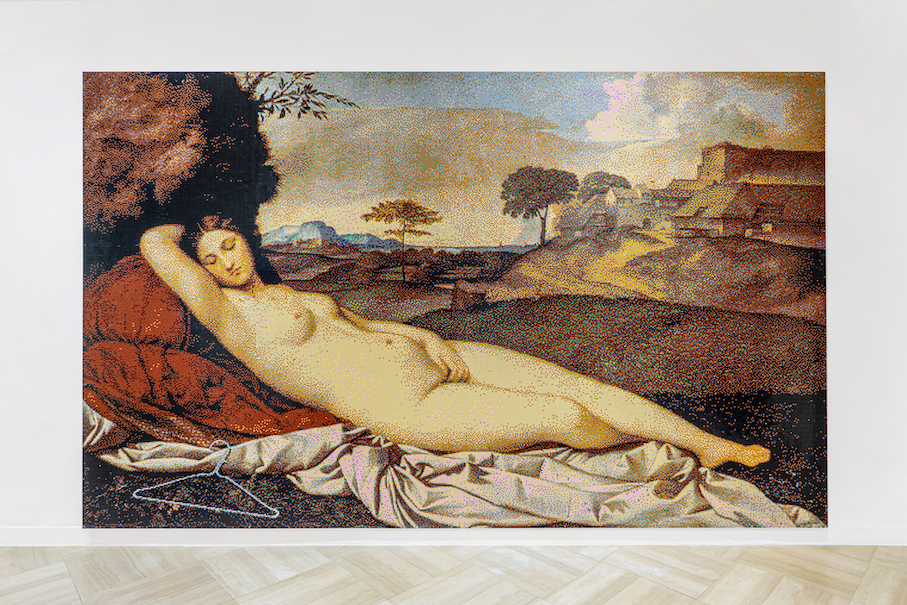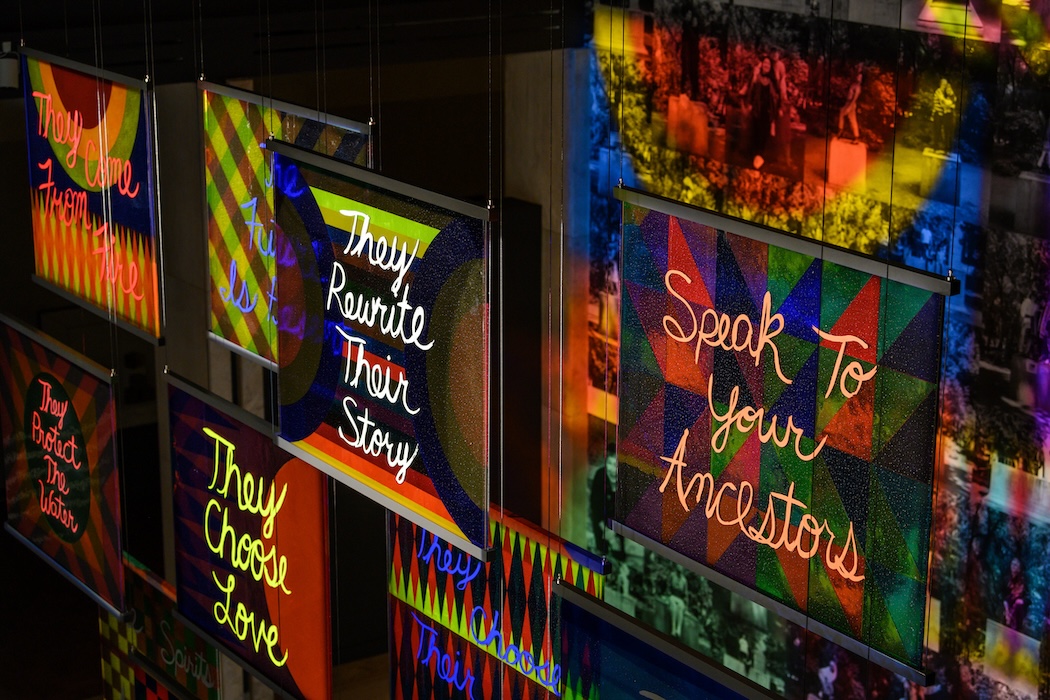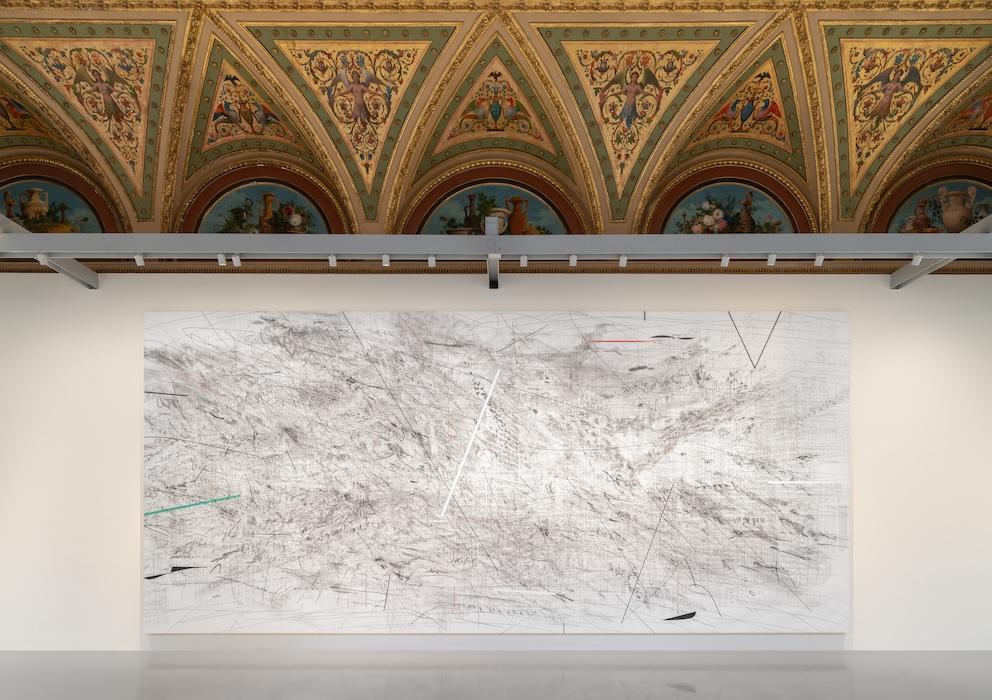At its core, the German Pavilion in this year’s Venice Biennale, curated by Çağla Ilk, embodies a defiant assertion of hope, transcending the confines of the present moment. Venturing beyond the pavilion’s walls onto the island of La Certosa, “Thresholds” unfolds as a transdisciplinary journey, disrupting certainties and creating transient perceptual spaces. The group show entitled “Thresholds” includes work by artists Yael Bartana and Ersan Mondtag at the pavilion, and Michael Akstaller, Nicole L’Huillier, Robert Lippok, and Jan St. Werner on La Certosa. Together they challenge conventional notions, immersing viewers in sensory experiences that defy categorization. As boundaries blur and contexts shift, the threshold comes into view not as a destination but as a transformative space of perpetual motion and possibility.
The German Pavilion as a Call to Action
“Thresholds” is a collective call to action, resonating throughout the exhibition, urging visitors to confront our collective future. As Ilk articulates, “Hope lies in movement within the threshold, in refusing to accept arrival as a benchmark.”
Amidst the dialogue between history and the present moment, the German Pavilion stands as a beacon of resilience and reflection. From Mondtag’s monumental earthworks to Bartana’s visionary narratives, each artwork evokes a profound sense of temporality and transcendence. Reminding visitors that the future is not set in stone but shaped by collective actions and goals, the pavilion inspires contemplation and discourse.
In an interview with Whitewall, Ilk delves into the curatorial vision behind “Thresholds,” illuminating how the pavilion aims to ignite broader conversations about identity, borders, and the unity of humanity.
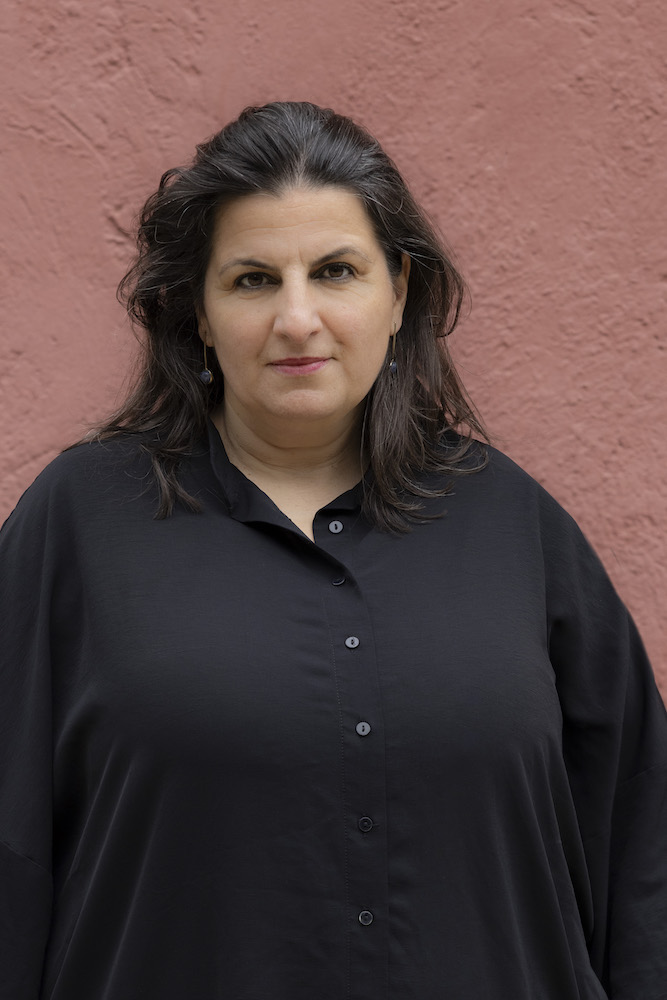
Çağla Ilk, Curator of the German Pavilion. Photo by Andrea Rossetti. © German Pavilion.
WHITEWALL: Could you elaborate on the concept of “Thresholds” as the overarching theme of the German Pavilion and its relation to the notion of transitional spaces and deterritorialization?
ÇAGLA ILK: From the very beginning, I have been deeply intrigued by the notion of perpetual motion. This mirrors the shared experience of countless individuals globally, navigating through the currents of migration. Moreover, it intertwines with the narrative of urban development; cities ebb and flow with the tide of migration, expanding with influxes and contracting in their absence. The stark reality emerges: a significant portion of the global population resides far from their birthplaces, underscoring the fluidity of our contemporary existence.
In recent years, we have witnessed a phenomenon crystallize into a pressing concern, particularly amidst the rise of right-wing movements. Instead of embracing the present and envisioning a future, there is a tendency to be tethered to a romanticized past. This longing for bygone eras, especially amidst crises, becomes a nostalgic beacon of supposed stability.
This political issue, fraught with apprehension about what lies ahead, is further exacerbated by the onslaught of environmental upheaval, political discord, and the seismic impact of pandemics. Against this backdrop, the concept of thresholds emerges as a potent metaphor, representing liminal spaces where the path forward is shrouded in uncertainty, blurring the delineation between past and future.
In essence, “Thresholds” encapsulates not only a physical crossing but also a profound psychological and existential journey. It beckons us to confront the transience of our circumstances, challenging us to navigate the shifting landscapes of our collective destiny with courage and resilience.
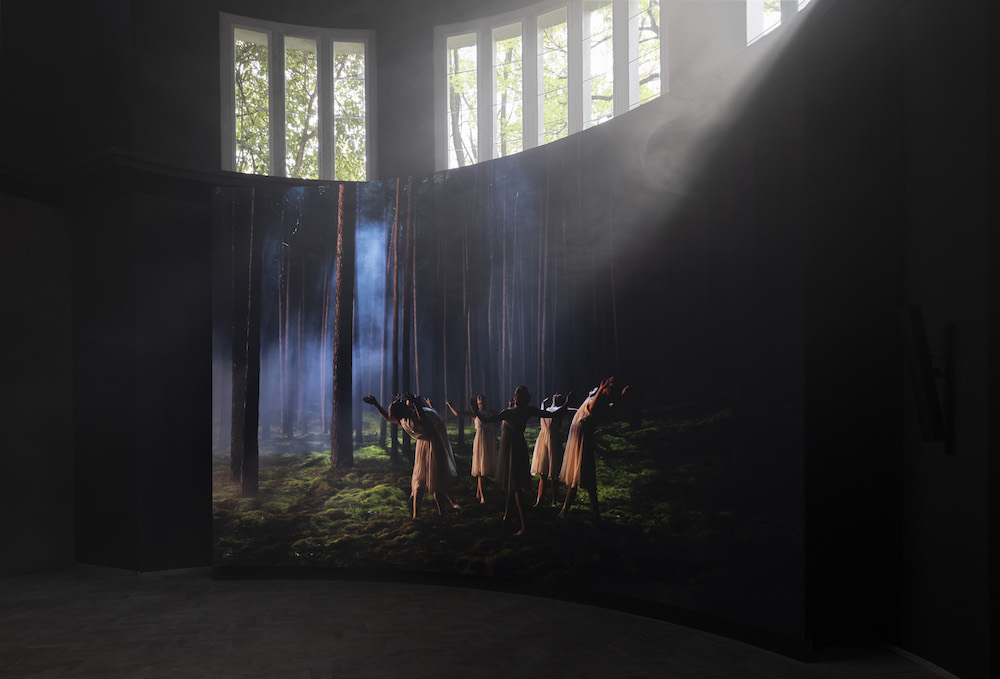
Yael Bartana, “Farewell”, 2024 as part of “Light To The Nations”, 2022-2024. Photo by Andrea Rossetti. © German Pavilion.
“Thresholds” Offers a Global Shift in Perspective in Venice
WW: The exhibition challenges traditional notions of national identity and borders. How do you envision this approach influencing the viewer’s perception of cultural and spatial constructs?
ÇI: In contemplating the impact of the exhibition, we delve deeply into the notion of how our collective past shapes our present identity. This encompasses not only recent history but also the long-standing cultural narratives that have shaped our societies over time. As we witness the movement of people across borders, we observe the transmission of cultural forms and traditions, each migrant carrying with them a piece of their heritage. This dynamic challenges conventional perceptions of national identity and borders, prompting us to reconsider the fluidity and complexity of cultural constructs.
This shift in perspective poses a particular challenge within the context of German society, where entrenched historical narratives often dominate the discourse. Our aim has been to amplify the voices of marginalized communities, to elevate the experiences of the underrepresented and to challenge the hegemonic structures that perpetuate inequality. By doing so, we strive to foster a more inclusive understanding of cultural identity, one that transcends political boundaries and embraces the diversity of human experience.
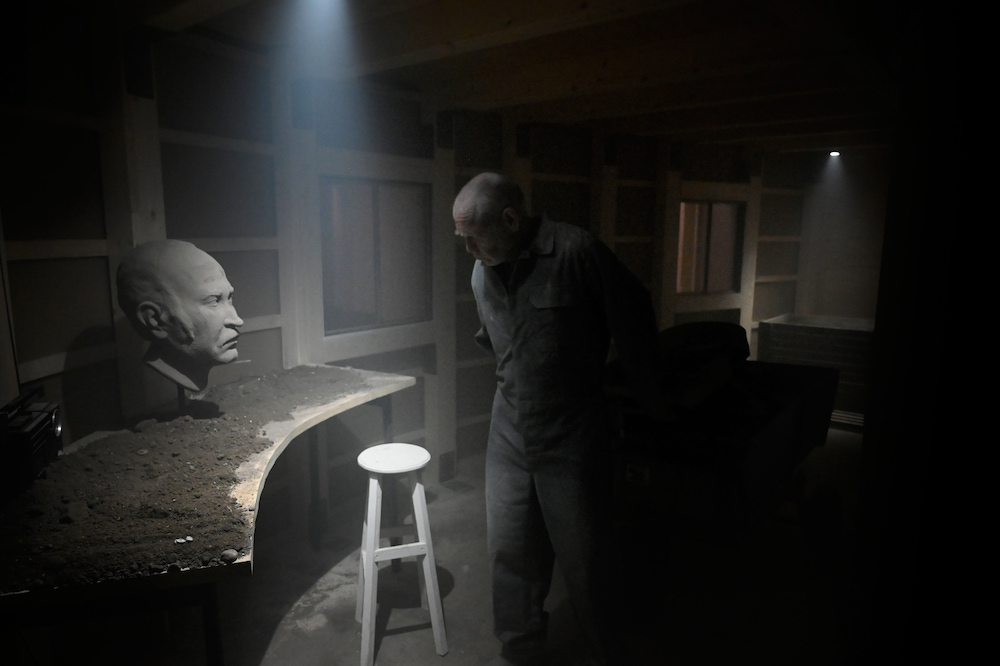
Ersan Mondtag, “Monument eines unbekannten Menschen” (“Monument Of An Unknown Person”), 2024. Performance View. Photo by Thomas Aurin. © German Pavilion.
Through this approach, we hope to engender a profound shift in the viewer’s perception of cultural and spatial constructs. By exposing the limitations of traditional notions of identity and borders, we invite audiences to engage critically with the complexities of our globalized world. Ultimately, our goal is to catalyze meaningful dialogue and inspire positive change, paving the way for a more equitable and interconnected future.
WW: Ersan Mondtag’s work, “Monument eines unbekannten Menschen” (Monument to the Unknown Person), makes a powerful statement about the pavilion’s history. What inspired the decision to incorporate such a dramatic installation, and what message do you hope it conveys to visitors?
ÇI: We were driven by a profound desire to narrate the story of the countless individuals who have either embarked on migrations or tragically lost their lives in the process. These narratives often remain hidden, relegated to the sidelines of history. Our aim was to illuminate one such intimate and untold story, a story that reflects the shared human experiences of displacement and loss.
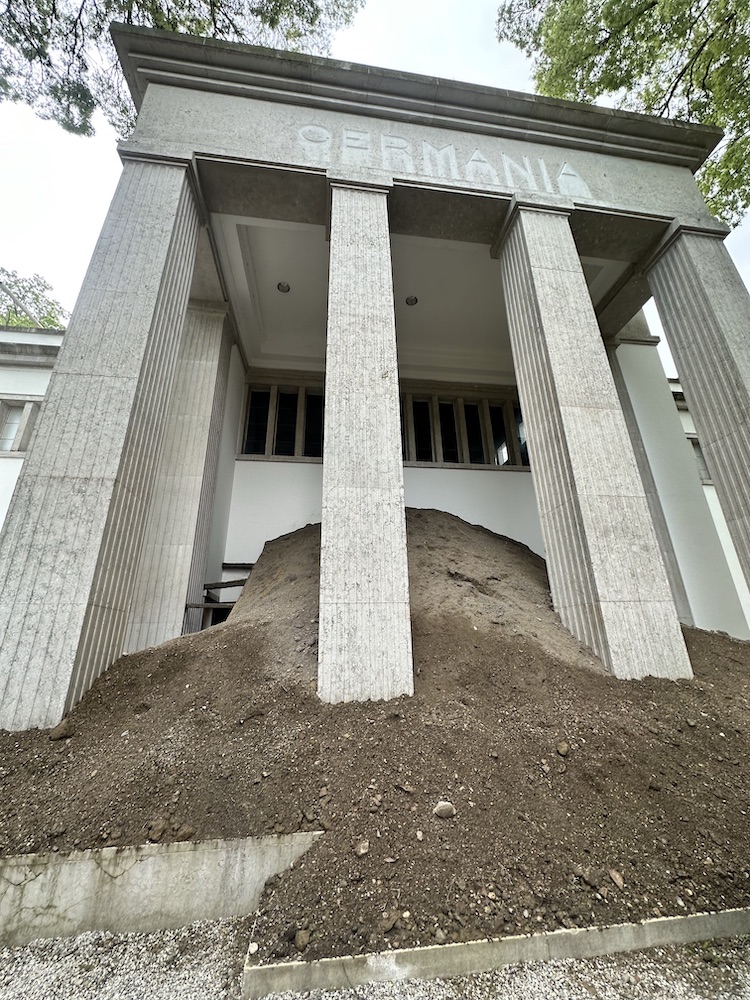
Ersan Mondtag, “Monument eines unbekannten Menschen” (“Monument Of An Unknown Person”). Photo by Ana Novi for Whitewall.
The German Pavilion Extends to La Certosa
WW: La Certosa offers a unique setting for part of the exhibition. Could you discuss the significance of choosing this location and how it enhances the overall experience for viewers?
ÇI: La Certosa presents an unparalleled backdrop for a segment of our exhibition. The significance of selecting this location lies in its role in deterritorialising the concept of national belonging. Symbolically, the island represents a departure from conventional notions of space, serving as a new pavilion that challenges hierarchical structures and architectural confines.
Choosing La Certosa offers viewers a transformative experience, as they step into a space where traditional boundaries blur, and cultural identities merge. Visitors can immerse themselves in an environment where they feel a profound sense of identification and interconnectedness.
However, navigating this shift is not without its challenges. With over 120 years of history, the German Pavilion’s legacy looms large in the background. While the pavilion may not inherently belong to the underprivileged, its transformation into a space of inclusivity and diversity marks a crucial step toward reshaping our collective narrative.
WW: The collaboration with artists like Michael Akstaller, Nicole L’Huillier, Robert Lippok, and Jan St. Werner seems to create a multidimensional exploration of space and perception. How did you approach integrating their diverse artistic languages into the exhibition?
ÇI: The collaboration with artists such as Michael Akstaller, Nicole L’Huillier, Robert Lippok and Jan St. Werner represents a profound multidimensional exploration of space and perception. This integration of diverse artistic languages into the exhibition was approached with a long-term vision. These artists have been integral to our program for years, and their collective contributions weave ongoing narratives that evolve over time. Rather than continuously seeking out new individuals, we fostered a sense of familial cohesion, allowing for a depth of understanding and collaboration to flourish.
WW: The absence of traditional exhibition boundaries, is a notable feature of the German pavilion. How does this deliberate choice affect the viewer’s engagement with the artwork and the overall narrative of the exhibition?
ÇI: It encapsulates an exploration of how diverse forms, sounds, and aesthetics can seamlessly converge to narrate distinctly unique stories. It’s a quest for unity amidst diversity, where each element shares the same space, yet retains its individual essence. This symbiotic relationship is crucial, as it allows different narratives to coexist harmoniously, captivating both the intellect and the emotions of the audience.
In this dynamic space, every piece contributes to a rich tapestry of ideas, forming a cohesive yet multifaceted narrative. Such coherence ensures that no aspect overshadows another, maintaining a delicate balance that elevates the collective vision of the exhibition.
This approach fosters a dual conversation, where each artwork holds its own significance while contributing to a broader dialogue. It’s a testament to the artists’ acute awareness of each other’s practices and visions, allowing them to collaborate symbiotically within the pavilion. Ultimately, it’s through this collaborative spirit that the German pavilion transcends traditional boundaries, creating an immersive and thought-provoking experience for its audience.
Yael Bartana’s “Light to the Nations”
WW: Yael Bartana’s work, “Light to the Nations” raises questions about humanity’s future and the possibility of leaving Earth. What message do you hope visitors take away from this thought-provoking piece?
ÇI: We should take actions so that scenarios portrayed do not become reality. Bartana’s piece prompts us to confront the pressing questions about humanity’s future and the potentiality of leaving Earth behind. Rather than passively observing, we are impelled to consider our role in shaping the course of events. The scenarios portrayed serve as a stark reminder of the fragility of our existence and the urgent need for proactive measures to safeguard our planet and collective future. It’s a rallying cry for collective action and a reminder of our responsibility to protect and preserve the world we inhabit.

Yael Bartana, “Light To The Nations – Generation Ship”, 2024, 3D Model, Installation View. Photo by Andrea Rossetti. © German Pavilion.
WW: Georgi Gospodinov’s novel, “Time Shelter”, is referenced as addressing themes of nostalgia and the pressure to act in the present. How does the exhibition respond to these themes, particularly in the context of shaping perceptions of history and the present moment?
This is accomplished through our sound work. They capture the essence of a frozen moment in time, effectively recreating the theatre of memory. We’re prompted to ponder: are we merely recollecting time through isolated events that occurred?
WW: The idea of hope is mentioned as a guiding principle in the exhibition, despite the challenges of the present moment. Can you expand on how the concept of hope is manifested within the artworks and the overall experience of the pavilion?
ÇI: Embedded within the artworks and the overall experience of the pavilion is a profound sense of resilience and optimism. The narratives we present, while sometimes depicting harsh realities, also offer glimpses of possibility and transformation.
Consider the poignant scenario depicted in the heart of our exhibition, a narrative grounded in truth and devoid of fiction. It’s a tale of displacement, of lives uprooted and worlds left behind—a narrative echoing the experiences of migrants forced to leave their homelands. In contemplating the idea of leaving Earth aboard a spaceship, we confront the weight of such a decision and the immense hope it carries. It symbolizes not only a physical departure but also a collective yearning for regeneration and renewal, a dream of a better future for humanity and our planet.
In this context, I am reminded of the profound words from Thomas Moore’s “Utopian Alphabet”:
“Utopos me General from not island made island,
Alone I of-lands all without philosophy
State philosophical I-have-formed for-mortals,
Willingly I-impart my-things, not not-willingly I-accept better-ones.”
This quote encapsulates the essence of our journey—a willingness to embark on a voyage into the unknown, to shape our destiny with hope and determination, and to embrace the challenges and opportunities that lie ahead. As artists, we have a responsibility to infuse our work with this hope, to inspire others to dream of a brighter tomorrow, and to contribute to the collective effort of building a more compassionate and sustainable world.
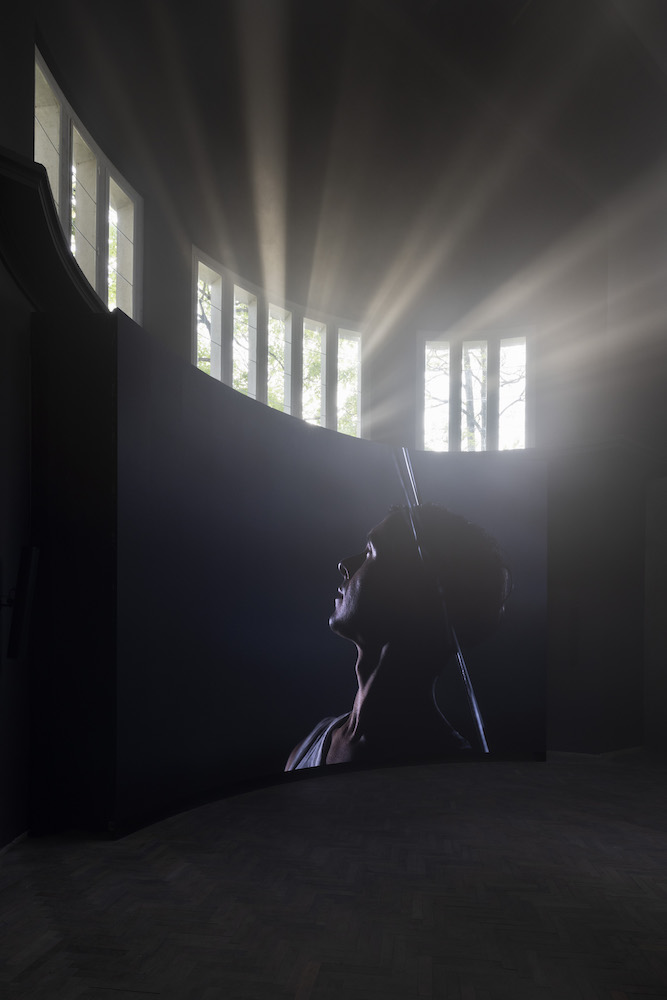
Yael Bartana, “Farewell”, 2024 as part of “Light To The Nations”, 2022-2024. Photo by Andrea Rossetti. © German Pavilion.
“If our work succeeds in influencing even one mind, then we have achieved our aim,” — Çağla Ilk
WW: In conclusion, how do you envision the impact of “Thresholds” extending beyond the exhibition space, both in terms of shaping discourse within the art world and fostering broader conversations about identity, borders, and collective action?
ÇI: If it changes one person’s mind, I consider the pavilion successful. Influencing people is not, as it involves contending with the multifaceted forces of economics, digital media and politics. Yet, through our art, we have the power to evoke emotions, provoke thought, and inspire change.
By challenging conventional notions and transcending boundaries, “Thresholds” opens doors to dialogue and introspection. It prompts us to consider our understanding of identity, to question borders and to recognize the importance of collective action in addressing global challenges.
As our exhibition continues to resonate with audiences, I hope it will catalyze a ripple effect, sparking discussions, fostering empathy and ultimately contributing to a more inclusive society. So, if our work succeeds in influencing even one mind, then we have achieved our aim and paved the way for meaningful transformation.
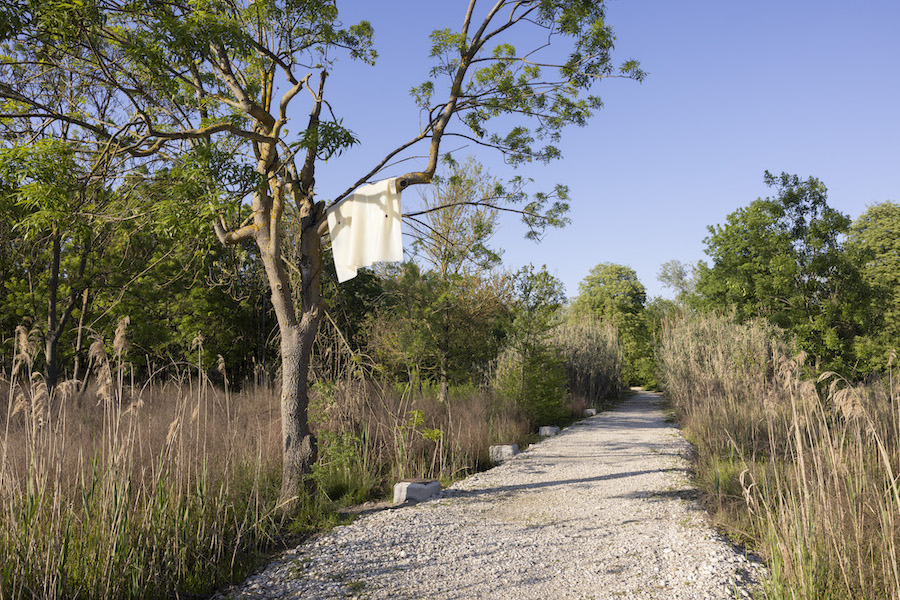
Nicole L’Huillier, “Encuentros”, 2024, Installation View La Certosa. Photo by Andrea Rossetti. © German Pavilion.



